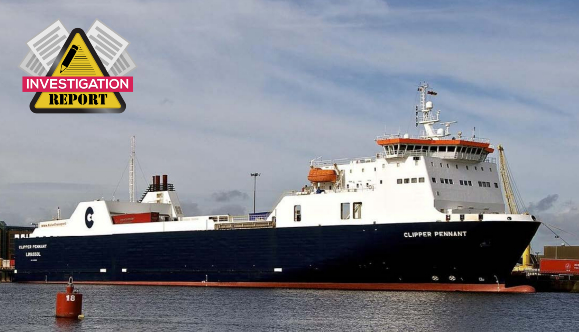UK MAIB released its initial findings of the investigation into the fatal accident on board the ro-ro ferry Clipper Pennant.
The case
At about 1400 on 20 July 2021, the bosun of the roll-on roll-of cargo ferry Clipper Pennant suffered fatal crushing injuries during cargo loading operations. Clipper Pennant was in Liverpool and the bosun was working on the upper vehicle deck, marshalling tractor unit drivers who were loading semi-trailers.
Two other crew members were on the upper vehicle deck, assisting the bosun by locating the resting trestles and lashing the semi-trailers once in position.
The accident occurred after the bosun had directed a tractor unit driver to push a semi-trailer into its stowage location, between a semi-trailer that had already been lashed and the bulkhead at the port forward end of the upper vehicle deck.
As the semi-trailer was being manoeuvred, the bosun had positioned himself between the moving semi-trailer and the vessel’s structure, resulting in the crushing accident.
According to MAIB, Clipper Pennant’s Deck Safety and Procedures Guide included instructions for deck crew, which stated that ‘during the loading of trailers, crewmembers must not stand behind the trailer. Never walk behind a moving vehicle or position yourself outside the sight of the tug driver’.
Findings
Where tractor units are being used to position semi-trailers, there is an extreme risk of crushing injuries, particularly where the semi-trailer is manoeuvring close to the ship’s structure, with limited means of escape for crew on deck.
Actions taken
Use of the port forward cargo stowage spaces has been temporarily suspended by the vessel’s operator, pending futher investigation and assessment.
Lessons learned
- Where tractor units are being used to push semi-trailers, safety procedures must be in place to ensure that deck crew are not standing in the vehicle’s path.
- Review cargo handling procedures to identify the hazards associated with stowage spaces where there may be limited areas for escape.
- Conduct a specifc risk assessment for all such spaces. These spaces should then be marked and, unless appropriate mitigating measures can be put in place, not used.
- Ensure that onboard safety procedures and crew safety briefngs refect the guidance in COSWP Section 27.6.3.































































